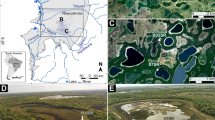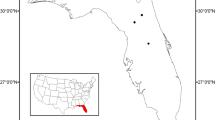Abstract
Biogeochemical studies were undertaken of a 65-cm long sediment core from Lake Cantara South, South Australia. 14C determinations indicated that the sediments had been deposited over 2000 years. Changes with sediment depth in the concentration or ratio of the following were determined: (i) total organic carbon, total carbonate (inorganic) carbon, total sulfur, total carbon, total inorganic and organic sulfur, atomic C/N, and sulfate/chloride; (ii) n-alkanes; (iii) a highly branched isoprenoid alkane, and (iv) steroids. Interpretation of the changes with sediment depth indicated the nature of changes that took place when the system changed from a protected marine lagoon to an isolated (athalassic) saline lake. This change took place about 1000 years ago.
Similar content being viewed by others
References
Cranwell, P. A., 1973. Chain-length distribution of n-alkanes from lake sediments in relation to post-glacial environmental change. Fresh. Biol. 3: 259–265.
De Deckker, P. & M. C. Geddes, 1980. The seasonal fauna of saline lakes near the Coorong Lagoon, South Australia. Aust. J. mar. fresh. Res. 31: 667–699.
Dunlop, R. W. & P. R. Jeffries, 1985. Hydrocarbons of the hypersaline basins of Shark Bay, Western Australia. Org. Geochem. 8: 313–320.
Gearing, P. J., J. N. Gearing, T. F. Lytle & J. S. Lytle, 1976. Hydrocarbons in 60 north east Gulf of Mexico Shelf sediments: a preliminary study. Geochim. Cosmochim. Acta, 40: 1005–1017.
Huang, W. Y. & W. G. Meinshein, 1979. Sterols as ecological indicators. Geochim. Cosmochim. Acta, 43: 739–745.
Kenig, F., A. Y. Huc, B. H. Purser & J. L. Oudin, 1990. Sedimentation, distribution and diagenesis of organic matter in a recent carbonate environment, Abu Dhabi, U.A.E. In Baker, E. W. & A. G. Douglas (eds), Advances in Organic Geochemistry 1989. 735-747. Org. Geochem. 16: 735–747.
Kenig, F., J. S. Sinninghe Damste, N. L. Frewin, J. M. Hayes & J. W. de Leeuw, 1995. Molecular indicators for palaeoenvironmental change in a Messinian evaporitic sequence (vana del Gesso, Italy). II: High-resolution variations in abundances and 13C contents of free and sulphur-bound carbon skeletons in a single marl bed. Org. Geochem. 23(6): 485–526.
Meissner, F. F., J. Woodward & J. L. Clayton, 1984. Stratigraphic relationship and distribution of source rocks in the Greater Rocky Mountain Region. In: Woodward J., F. F. Meissner & J. L. Clayton (eds), Hydrocarbon Source Rocks of Greater Rocky Mountain Region. Rocky Mountain Association of Geology, Denver, CO.: 1–34.
Meyers, P. A. & R. Ishiwatari, 1993, Lacustrine organic geochemistry – an overview of indicators of organic matter sources and diagenesis in lake sediments. In: Meyers, P. A. & R. Ishiwatari (eds), Lacustrine Organic Geochemistry. Org. Geochem. 20: 867–900.
Nichols, P. D., Volkman, J. K., Palmisano, A. K., Smith, J. A. & D. C. White, 1988. Occurrence of an isoprenoid C25 diunsaturated alkene and high neutral lipid content in Antarctic sea-ice diatom communities. J. Phycol. 24: 90–96.
Requejo, A. G., J. G. Quinn, J. N. Gearing & P. J. Gearing, 1984. C25 and C30 biogenic alkenes in sediment from upper anoxic basin of the Pettaquamscutt River (Rhode Island, U.S.A.). Org. Geochem. 7: 1–10.
Robson, J. N., 1987. Synthetic and biodegradation studies of some novel isoprenoid hydrocarbons. Ph.D. Thesis, Plymouth Polytechnic, Plymouth, 242 pp.
Robson, J. N. & S. J. Rowland, 1988. Biodegradation of highly branched isoprenoid hydrocarbons: a possible explanation of sedimentary abundance, In: Mattavelli, L. & L. Novelli (eds), Advances in Organic Geochemistry Part II Analytical Geochemistry. Org. Geochem. 13: 691–695.
Rowland, S. J., D. A. Yon, C. A. Lewis, & J. R. Maxwell, 1985. Occurrence of 2,6,10-trimethyl-7-(3-methylbutyl)dodecane and related hydrocarbons in the green alga Enteromorpha prolifera and sediments. Org. Geochem. 8: 207–213.
Seifert, W. K. & J. M. Moldowan, 1981. Paleoreconstruction by biological markers. Geochim. Cosmochim. Acta 45: 783–794.
Thoms, M. C. & W. D. Williams, 1993. The siliceous sediments of Lake Cantara South, a saline lake in South Australia. Int. J. Salt Lake Res. 2(1): 29–40.
Volkman, J. K., 1986. A review of sterol markers for marine and terrigenous organic matter. Org. Geochem. 9: 83–99.
Volkman, J. K., S. M. Barrett & G. A. Dunstan, 1994. C25 and C30 highly branched isoprenoid alkenes in laboratory cultures of two marine diatoms. Org. Geochem. 21(3/4): 407–413.
von der Borch, C. C., 1976. Stratigraphy and formation of Holocene dolomitic carbonate sediments of the Coorong area, South Australia. J. sediment. Petrol. 46: 952–966.
Warren, J. K., 1988. Sedimentology of Coorong dolomite in the Salt Creek region, South Australia. Carbonates Evaporites 3(2): 175–199.
Warren, J. K., 1990. Sedimentology and mineralogy of dolomitic Coorong lakes, South Australia. J. sediment. Petrol. 60(6): 843–858.
Williams, W. D., 1986. Conductivity and salinity of Australian salt lakes. Aust. J. mar. freshwat. Res. 37: 177–182.
Yon, D. A., G. Ryback & J. R. Maxwell, 1982. 2,6,10-trimethyl-7-(3-methylbutyl)dodecane, a novel sedimentary biological marker compound. Tetrahedron Lett. 23: 2143–2146.
Author information
Authors and Affiliations
Rights and permissions
About this article
Cite this article
Wang, R.L., Williams, W.D. Biogeochemical changes in the sediments of Lake Cantara South, a saline lake in South Australia. Hydrobiologia 457, 17–24 (2001). https://doi.org/10.1023/A:1012225311553
Issue Date:
DOI: https://doi.org/10.1023/A:1012225311553




